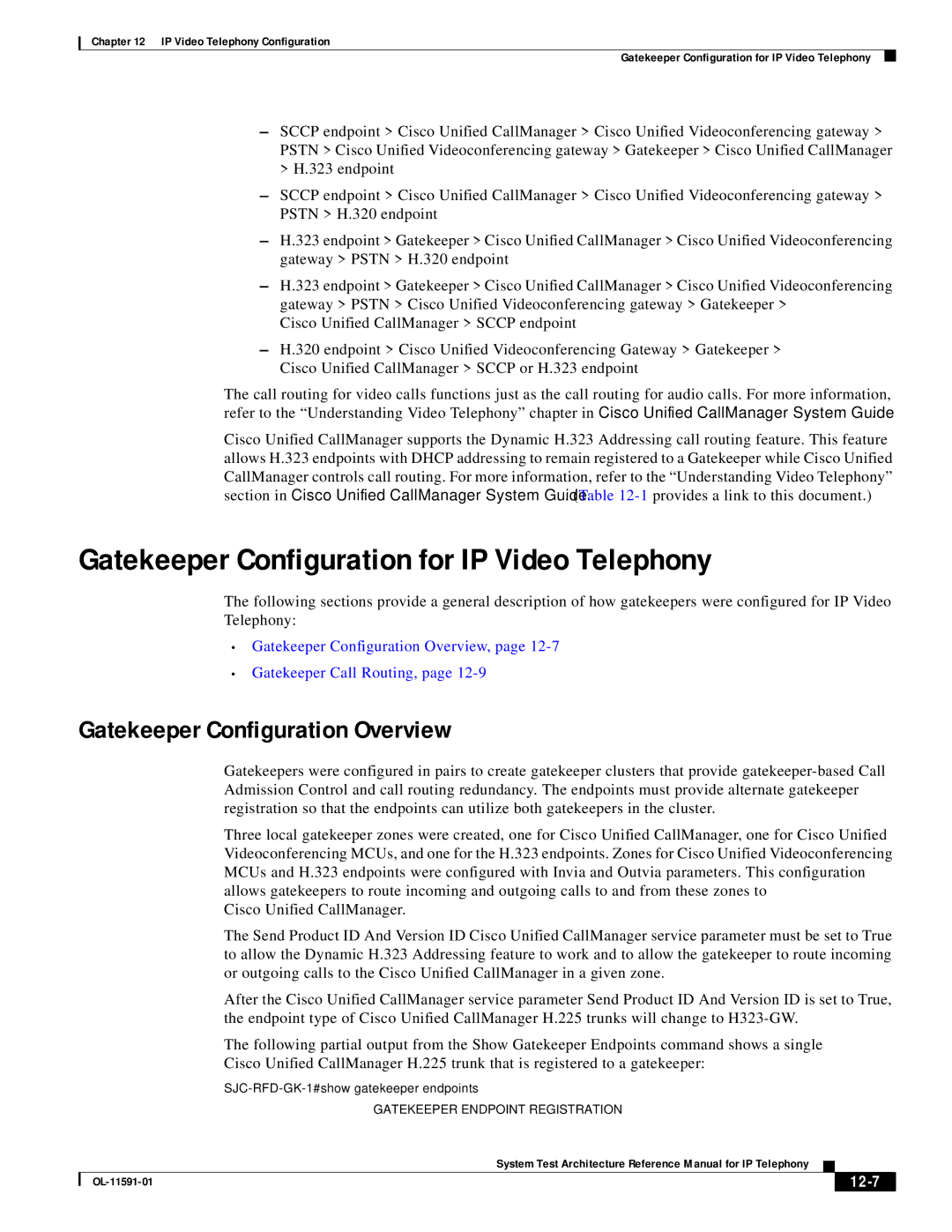Chapter 12 IP Video Telephony Configuration
Gatekeeper Configuration for IP Video Telephony
–SCCP endpoint > Cisco Unified CallManager > Cisco Unified Videoconferencing gateway > PSTN > Cisco Unified Videoconferencing gateway > Gatekeeper > Cisco Unified CallManager > H.323 endpoint
–SCCP endpoint > Cisco Unified CallManager > Cisco Unified Videoconferencing gateway > PSTN > H.320 endpoint
–H.323 endpoint > Gatekeeper > Cisco Unified CallManager > Cisco Unified Videoconferencing gateway > PSTN > H.320 endpoint
–H.323 endpoint > Gatekeeper > Cisco Unified CallManager > Cisco Unified Videoconferencing gateway > PSTN > Cisco Unified Videoconferencing gateway > Gatekeeper >
Cisco Unified CallManager > SCCP endpoint
–H.320 endpoint > Cisco Unified Videoconferencing Gateway > Gatekeeper > Cisco Unified CallManager > SCCP or H.323 endpoint
The call routing for video calls functions just as the call routing for audio calls. For more information, refer to the “Understanding Video Telephony” chapter in Cisco Unified CallManager System Guide.
Cisco Unified CallManager supports the Dynamic H.323 Addressing call routing feature. This feature allows H.323 endpoints with DHCP addressing to remain registered to a Gatekeeper while Cisco Unified CallManager controls call routing. For more information, refer to the “Understanding Video Telephony” section in Cisco Unified CallManager System Guide. (Table
Gatekeeper Configuration for IP Video Telephony
The following sections provide a general description of how gatekeepers were configured for IP Video Telephony:
•Gatekeeper Configuration Overview, page
•Gatekeeper Call Routing, page
Gatekeeper Configuration Overview
Gatekeepers were configured in pairs to create gatekeeper clusters that provide
Three local gatekeeper zones were created, one for Cisco Unified CallManager, one for Cisco Unified Videoconferencing MCUs, and one for the H.323 endpoints. Zones for Cisco Unified Videoconferencing MCUs and H.323 endpoints were configured with Invia and Outvia parameters. This configuration allows gatekeepers to route incoming and outgoing calls to and from these zones to
Cisco Unified CallManager.
The Send Product ID And Version ID Cisco Unified CallManager service parameter must be set to True to allow the Dynamic H.323 Addressing feature to work and to allow the gatekeeper to route incoming or outgoing calls to the Cisco Unified CallManager in a given zone.
After the Cisco Unified CallManager service parameter Send Product ID And Version ID is set to True, the endpoint type of Cisco Unified CallManager H.225 trunks will change to
The following partial output from the Show Gatekeeper Endpoints command shows a single
Cisco Unified CallManager H.225 trunk that is registered to a gatekeeper:
GATEKEEPER ENDPOINT REGISTRATION
|
| System Test Architecture Reference Manual for IP Telephony |
|
| ||
|
|
| ||||
|
|
|
|
| ||
|
|
|
| |||
